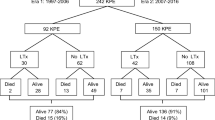Abstract
Purpose
Open portoenterostomy (PE) for biliary atresia (BA) is currently more extended (EP) than the original (OP). Typical OP techniques, shallow transection of the biliary remnant and shallow suturing, both lost in EP, were revived as a modified procedure (MP). Postoperative outcomes of EP and MP were compared.
Methods
Subjects were 55 consecutive BA patients treated by EP (n = 18) or MP (n = 37) at a single center between 2004 and 2021.
Results
Mean follow-up duration was: MP: 15.5 years (range 0.1–12.3 years) and EP: 15.5 years (range 0.38–17.1 years). The ratio of jaundice free (JF; total bilirubin ≤ 1.2 mg/dL) subjects was significantly higher in MP (78.4%) versus EP (50%); p > 0.05, the incidence of bile lakes at the porta hepatis was significantly higher in MP (7/37: 18.9%) versus EP (0/18: 0%); p > 0.05, and Kaplan–Meier analysis showed JF survival with the native liver (JF + SNL) was significantly better in MP (26/37: 70.2%) versus EP (4/18: 22.2%); p > 0.05. All other criteria were similar. Of note, time taken to become JF and the incidence of cholangitis were not significantly different.
Conclusions
Shallow transection and shallow suturing would appear to influence postoperative outcome. The etiology of bile lake formation in MP requires urgent confirmation.


Similar content being viewed by others
References
Kasai M, Suzuki S (1959) A new operation for “non-correctable” biliary-atresia, hepatic portoenterstomy. Shujutsu 13:733–739
Hartley JL, Davenport M, Kelly DA (2009) Biliary atresia. Lancet 374:1704–1713. https://doi.org/10.1016/S0140-6736(09)60946-6
Wada M, Nakamura H, Koga H, Miyano G, Lane GJ, Okazaki T et al (2014) Experience of treating biliary atresia with three types of portoenterostomy at a single institution: extended, modified Kasai, and laparoscopic modified Kasai. Pediatr Surg Int 30:863–870. https://doi.org/10.1007/s00383-014-3551-5
Nakamura H, Koga H, Wada M, Miyano G, Dizon R, Kato Y et al (2012) Reappraising the portoenterostomy procedure according to sound physiologic/anatomic principles enhances postoperative jaundice clearance in biliary atresia. Pediatr Surg Int 28:205–209. https://doi.org/10.1007/s00383-011-3019-9
Davenport M (2012) Biliary atresia: clinical aspects. Semini Pediatr Surg 21:175–184. https://doi.org/10.1053/j.sempedsurg.2012.05.010
Nio M, Ohi R (2000) Biliary atresia. Semini Pediatr Surg 9:177–186. https://doi.org/10.1053/spsu.2000.18846
Kobayashi H, Yamataka A, Urao M, Okazaki T, Yanai T, Koga H et al (2006) Innovative modification of the hepatic portoenterostomy. Our experience of treating biliary atresia. J Pediatr Surg 41:e19-22. https://doi.org/10.1016/j.jpedsurg.2005.12.056
Nakajima H, Koga H, Okawada M, Nakamura H, Lane GJ, Yamataka A (2018) Does time taken to achieve jaundice-clearance influence survival of the native liver in post-Kasai biliary atresia? World J Pediatr 14:191–196. https://doi.org/10.1007/s12519-018-0139-5
Altman RP, Lilly JR, Greenfeld J, Weinberg A, van Leeuwen K, Flanigan L (1997) A multivariable risk factor analysis of the portoenterostomy (Kasai) procedure for biliary atresia: twenty-five years of experience from two centers. Ann Surg 226:348–353. https://doi.org/10.1097/00000658-199709000-00014 (discussion 53-5)
Azarow KS, Phillips MJ, Sandler AD, Hagerstrand I, Superina RA (1997) Biliary atresia: should all patients undergo a portoenterostomy? J Pediatr Surg 32:168–172. https://doi.org/10.1016/s0022-3468(97)90173-1 (discussion 72-4)
Nio M, Ohi R, Miyano T, Saeki M, Shiraki K, Tanaka K et al (2003) Five- and 10-year survival rates after surgery for biliary atresia: a report from the Japanese Biliary Atresia Registry. J Pediatr Surg 38:997–1000. https://doi.org/10.1016/s0022-3468(03)00178-7
Sasaki H, Tanaka H, Nio M (2017) Current management of long-term survivors of biliary atresia: over 40 years of experience in a single center and review of the literature. Pediatr Surg Int 33:1327–1333. https://doi.org/10.1007/s00383-017-4163-7
Shinkai M, Ohhama Y, Take H, Kitagawa N, Kudo H, Mochizuki K et al (2009) Long-term outcome of children with biliary atresia who were not transplanted after the Kasai operation: >20-year experience at a children’s hospital. J Pediatr Gastroenterol Nutri 48:443–450. https://doi.org/10.1097/mpg.0b013e318189f2d5
Betz BW, Bisset GS 3rd, Johnson ND, Daugherty CC, Balistreri WF (1994) MR imaging of biliary cysts in children with biliary atresia: clinical associations and pathologic correlation. AJR Am J Roentgenol 162:167–171. https://doi.org/10.2214/ajr.162.1.8273658
Bu LN, Chen HL, Ni YH, Peng S, Jeng YM, Lai HS et al (2002) Multiple intrahepatic biliary cysts in children with biliary atresia. J Pediatr Surg 37:1183–1187. https://doi.org/10.1053/jpsu.2002.34468
Takahashi A, Tsuchida Y, Suzuki N, Kuroiwa M, Ikeda H, Hirato J et al (1999) Incidence of intrahepatic biliary cysts in biliary atresia after hepatic portoenterostomy and associated histopathologic findings in the liver and porta hepatis at diagnosis. J Pediatr Surg 34:1364–1368. https://doi.org/10.1016/s0022-3468(99)90012-x
Tainaka T, Kaneko K, Nakamura S, Ono Y, Sumida W, Ando H (2008) Histological assessment of bile lake formation after hepatic portoenterostomy for biliary atresia. Pediatr Surg Int 24:265–269. https://doi.org/10.1007/s00383-007-2099-z
Tainaka T, Kaneko K, Seo T, Ono Y, Ogura Y, Wada H et al (2006) Hepatolithiasis after hepatic portoenterostomy for biliary atresia. J Pediatr Surg 41:808–811. https://doi.org/10.1016/j.jpedsurg.2005.12.036
Vazquez-Estevez J, Stewart B, Shikes RH, Hall RJ, Lilly JR (1989) Biliary atresia: early determination of prognosis. J Pediatr Surg 24:48–50. https://doi.org/10.1016/s0022-3468(89)80300-8 (discussion-1)
Goda T, Kawahara H, Kubota A, Hirano K, Umeda S, Tani G et al (2013) The most reliable early predictors of outcome in patients with biliary atresia after Kasai’s operation. J Pediatr Surg 48(12):2373–2377. https://doi.org/10.1016/j.jpedsurg.2013.08.009
Author information
Authors and Affiliations
Corresponding author
Additional information
Publisher's Note
Springer Nature remains neutral with regard to jurisdictional claims in published maps and institutional affiliations.
Rights and permissions
About this article
Cite this article
Abe, E., Koga, H., Nakamura, H. et al. Mid-term outcome of postoperative biliary atresia patients according to level of transection of the biliary remnant and depth of suturing. Pediatr Surg Int 38, 701–706 (2022). https://doi.org/10.1007/s00383-022-05097-z
Accepted:
Published:
Issue Date:
DOI: https://doi.org/10.1007/s00383-022-05097-z




